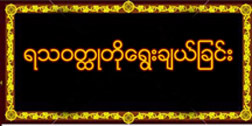Logical Reasoning
ME39 03-03-2011 (3:00 to 4:00)
(Class Notes Only)
------------------
On Knowledge of Beginnings, the Aggañña sutta provides a detail description of the origin of the human kind and the planet earth. At the beginning known as world contraction, the human ancestry started with the living beings born from the Abhassara Brahmas. After some long period feeding on the earth soils, the Brahma lost their body radiance and slowly changed in their body features. Then, the sun and moon started to appear in the firmament to start day and night time on earth. Then, everyone looks the same; there was no gender, only asexual.Later, after some long period, sex organs were formed on their body. And the women became excessively preoccupied with the men, and the men with the women. Owing to this excessive preoccupation with each other, passion was aroused, and their bodies burnt with lust.
And later because of this burning, they indulged in sexual activity. Trees appeared and rice was available freely. This description of the beginning of mankind is so different from the modern theory of human evolution.
The Lord Buddha was staying at Sāvatthi in the mansion of Migara’s mother, in the East Park. And at that time Vasettha and Bharadvaja were living among the monks. They went up to the lord. Then the lord said to Vasettha: “brāhmaṇova seṭṭho vaṇṇo, hīnā aññe vaṇṇā- the Brahmin caste is fair, other castes are dark,” “the Brahmins are the true children of Brahma, born from his mouth- brāhmaṇāva brahmuno puttā orasā mukhato jātā.” Then, Vasettha, we can see Brahmin women, the wives of Brahmins, “Dissanti kho pana, vāseṭṭha, brāhmaṇānaṃ brāhmaṇiyo utuniyopi gabbhiniyopi vijāyamānāpi pāyamānāpi- who menstruate and become pregnant, have babies, and give milk.” These Brahmins misrepresent Brahma, tell lies and earn much demerit.
The brahmins claimed that among the four classes of people recognised at that time brahmins were the noblest; next came the khattiya class (the nobility and royalty) followed by vessa (the trading class) and sudda (the lowest class). The Buddha refuted these claims of the brahmins by explaining how the world was subjected to processes of evolution and dissolution and describing how human beings first appeared on earth and how the four social classes emerged. He explained further that the nobility of a person was decided not by his birth and lineage but by his morality and knowledge of the Noble Truths.
"Whoever holds wrong views and commits misdeeds is not noble whatever his birth.
Whoever restrains himself in deed, word and thought and develops the bodhipakkhiya dhammas until he attains complete eradication of defilements in this very life is the chief, the noblest amongst men and devas irrespective of birth." Another good point was made in the same thread by son of dhamma, who said, "I don't consider that the world being talked about in the Aggañña Sutta is 'the universe'.
The Kevatta Sutta is a Buddhist scripture, one of the texts in the Digha Nikaya. The scripture takes its name from the householder Kevatta, who invites the Buddha to display various miraculous powers in order to show his spiritual superiority. The Buddha responds by expressing his belief that supernatural powers are not a valid measure of spiritual development, because they can be falsified through the use of charms and spells. In the First time: The Lord Buddha explains the various psychic powers that a monk can have..., a monk becomes many, and then becomes one again, he vanishes and re-appears, goes through walls, ramparts and mountains, dives in and out of earth, walks on water, flies through the air (pathavīdhātu āpodhātu tejodhātu vāyodhdhātu), with his hand touches and strokes the sun and the moon (!), and can reach even as far as the Brahma divine worlds He goes on to deliver a discourse on virtue, expressing the belief that it is virtuous conduct, rather than supernatural developments, that display the superiority or spiritual development of a teacher. He also states that such practices will give rise to powers greater than those available to practitioners of traditional magic and austerities.
The scripture is significant to the study of Buddhism because it constitutes one of the clearest statements in the scriptures of the Buddha's opposition to the notion of magical power and supernatural abilities as the best indicator of truth or virtue. In setting out such a belief, the Buddha placed himself in opposition to much of the popular religious traditions derived from the Vedas, which often focused on the acquisition of supernatural powers as an ends unto itself, and as a means of measuring spiritual worthiness.
The second one is obtained through logical inference. Sandaka Sutta indicates a difference between what is “well reasoned” (sutakkitam) and “ill reasoned” (dutakkitam) Suttanipãta admonishes that one should desist from the debate as it lures one to make use of falsehood. In the Pāli texts, we frequently find Buddha dissociating himself from this class of rationalists and criticizing views which are said to be based on different forms of reasoning and reflection. In the Saṅgārava Sutta, the consistency is no guarantee of their factual truth. Thus
with regard to rational theories there are four possibilities:
1. sutakkitaṃ tathā i.e. well-reasoned true
2. sutakkitaṃ aññathā i.e. well-reasoned false
3. duttakkitaṃ tathā i.e. ill-reasoned true
4. duttakkitaṃ aññathā i.e. ill-reasoned false
In the first scripture, Nyaysutra of Nyay Darshan, there are five chapters. Akshapad Gautam is the originator of Nyay Darshan. Nyaysutra is purely methodological in nature. This is the seventh material recognized in Nyay Darshan. It assists estimation. It has five kinds-
(i) Pratigya (Determination),
(ii) Hetu (Middle term),
(iii) Udaharan (example),
(iv) Upanaya (comparing) and
(v) Nigaman (conclusion). Early Buddhist scriptures introduce two kinds of knowledge i.e. Dhamme ñana which refers to knowledge of things or events and anvaye ñana or inductive knowledge. The first one is none other than experimental knowledge.
by Ashin Indaka(kyone Pyaw)























0 comments:
Post a Comment